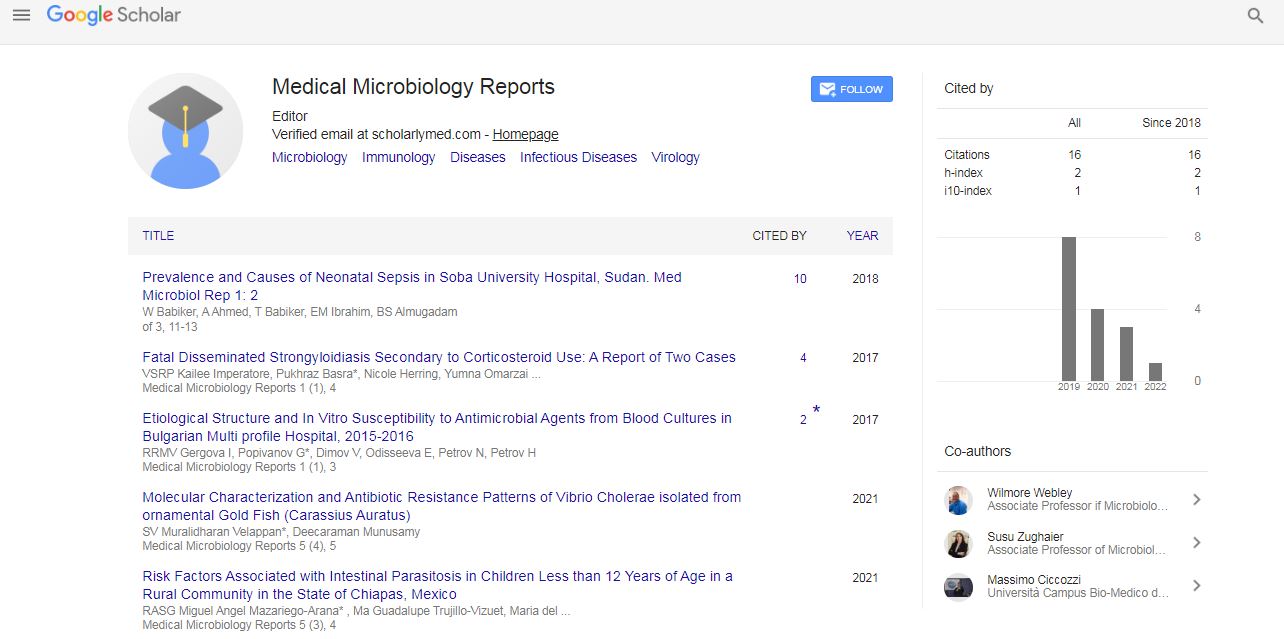Perspective, Med Microbiol Rep Vol: 7 Issue: 4
Conundrums in the Causes and Transmission of Fungal Diseases
Caravita Retno*
1Department of Ecology, Stockholm University, Stockholm, Sweden
*Corresponding Author: Caravita Retno,
Department of Ecology, Stockholm
University, Stockholm, Sweden
E-mail: caravret@su.se
Received date: 24 November, 2023, Manuscript No. MMR-24-128547;
Editor assigned date: 27 November, 2023, PreQC No. MMR-24-128547 (PQ);
Reviewed date: 11 December, 2023, QC No. MMR-24-128547;
Revised date: 18 December, 2023, Manuscript No. MMR-24-128547 (R);
Published date: 26 December, 2023, DOI: 10.4172/MMR.1000357
Citation: Retno C (2023) Conundrums in the Causes and Transmission of Fungal Diseases. Med Microbiol Rep 7:4.
Description
In the vast world of medical mycology, the causes and transmission of fungal diseases present a challenge with complexity and enigma. Fungal infections, once relegated to the field of opportunistic concerns, have emerged as substantial challenges in healthcare settings and broader ecosystems. Understanding the conundrums, surrounding the origins and transmission of these fungal diseases requires a nuanced exploration of fungal biology, ecological dynamics and the interaction between pathogens and their hosts. Fundamentally, the conundrum lies in the diverse nature of fungi, a kingdom distinct from bacteria and viruses. Fungal diseases or mycoses can be caused by various fungal species, each possessing unique characteristics. Some fungi are opportunistic, exploiting weakened immune systems, while others can infect healthy individuals.
Conundrums arise when endeavoring to identify the sources of fungal infections. The fungal diseases can be caused by a multitude of fungal species, each with its own ecological niche. Fungi thrive in diverse habitats, from soil and decaying organic matter to the human body. Identifying the primary reservoirs and sources of fungal pathogens transforms into an enigma, as these resilient organisms can persist in various environments and transition between different hosts. The human body, equipped with an elaborate immune system, is generally resilient to fungal invaders. However, conundrums arise when the immune system is compromised, allowing opportunistic fungi to exploit vulnerabilities.
Transmission dynamics add another layer of complexity to the conundrum. Fungal diseases can be transmitted through various routes, including inhalation of spores, direct contact with contaminated surfaces or even through interactions with other infected individuals. The variability in transmission mechanisms complicates efforts to establish standardized preventive measures. Nosocomial or healthcare-associated fungal infections contribute to the conundrum, posing significant challenges for patient care. In hospitals, patients with weakened immune systems, invasive medical procedures or prolonged antibiotic use are particularly susceptible to fungal infections. The sources of these infections may not always be clear as the conundrum of transmission within healthcare becomes imperative for implementing effective infection control measures.
The ecological context of fungal diseases introduces a layer of complexity that adds to the conundrum. Fungi play essential roles in nutrient cycling and ecosystem dynamics, but some can shift from symbiotic relationships to pathogenic interactions under certain conditions. Human activities, environmental changes and the globalization of trade contribute to the spread of fungal pathogens, making it challenging to predict and control the emergence of fungal diseases. The integration of ecological studies, epidemiology and clinical analysis becomes essential for resolving the complexities of fungal diseases in diverse contexts. In laboratories, mycologists work to identify the specific virulence factors that enable fungi to cause diseases. The progress is being made in the understanding and management of fungal diseases. Improved diagnostic technologies, including molecular assays and imaging techniques, enhance the accuracy and speed of identifying fungal pathogens. Antifungal drug development continues to evolve, with efforts focused on expanding the arsenal of treatments and addressing the challenges of drug resistance. Public awareness and education play a vital role in navigating the conundrums of fungal diseases. Understanding the risk factors, recognizing symptoms and promoting preventive measures contribute to early detection and effective management.
Conclusion
Healthcare professionals and analysts collaborate to develop guidelines and strategies that address the complex challenges posed by fungal infections. The conundrums persist in the causes and transmission of fungal diseases, reflecting the multifaceted nature of these infections. From the diversity of fungal pathogens to the complex equilibrium between host and microbe and from environmental complexities to emerging challenges in healthcare settings, solving challenges of fungal diseases requires a persistent and collaborative effort. As the conundrums persist in the analysis and the technological advancements, the comprehensive understanding of fungal biology resolves to render the procedure visible in reducing the impact of these enigmatic infections.
 Spanish
Spanish  Chinese
Chinese  Russian
Russian  German
German  French
French  Japanese
Japanese  Portuguese
Portuguese  Hindi
Hindi 
